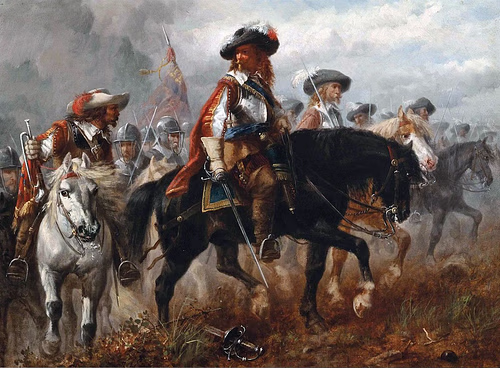 |
| Charles I at Naseby |
I am still researching my next novel. The blog helps me to keep track of the information. It is better than taking notes. From World History:
The Royalists were commanded by Charles himself with his nephew Prince Rupert (1619-1682) and George, Lord Digby (1612-1677). Their army consisted of between 8,000 and 10,000 troops, a little more than half of which was cavalry. Fairfax, meanwhile, commanded some 14,000 to 15,000 men (with a little over 6,000 of these being cavalry). Both armies had the usual cavalry on each wing and the infantry troops arranged in two rows of squares like a chessboard in the centre of the battlefield. The Parliamentarian dispositions may have been more compacted given the natural features of the terrain on their side of the battlefield and their greater numbers. Both sides would have wanted to avoid the parish border hedges on one side and the boggy ground caused by two streams on the other. Each infantry block was composed of a central core of pikemen with flanks of musketeers. The job of the pikemen was to protect the musketeers, and at this stage in the war, the typical ratio was one pikeman to every three musketeers.
Battle commenced around 10 am. First, there was an unusually short artillery barrage, perhaps because the Royalists were not yet ready and the Parliamentarian commanders did not generally favour this method of attack anyway. It may also have been that the uneven terrain meant sighting for artillery was poor. There then followed the inevitable clash of men at arms.
The Royalist cavalry led by Prince Rupert gained success on the right wing, driving the left wing of the Parliamentary cavalry towards Naseby. This wing of the Parliamentarian cavalry was led by Henry Ireton (1611-1651) who had only a limited experience of commanding large bodies of troops. Early on in the battle, Ireton was wounded and even briefly captured by the enemy. Meanwhile, in the centre of the battlefield, the Royalist infantry, led by Jacob Astley, initially outperformed the numerically superior Parliamentary infantry, led by the vastly experienced Philip Skippon (c. 1600-1660), forcing them to lose ground. This may actually have been a disadvantage for the Royalist infantry as they moved forward and exposed their flanks to the wings of the Parliamentary army, particularly as they were numerically inferior. Caught on three sides, the Royalist infantry was obliged to withdraw from the pocket, which disrupted their formation and exposed the men even further.
Crucially, Oliver Cromwell's cavalry on the right wing of the Parliamentarian army crushed the opposing cavalry, led by Sir Marmaduke Langdale (1598-1661), forcing them to flee the field completely. Cromwell then led his men to attack the Royalist infantry in the centre. Prince Rupert, not for the first time, was unable to match Cromwell's tactics since his cavalry became embroiled in a skirmish with the Parliamentarian baggage train far behind the enemy lines. Whether Rupert was personally involved here or by this time had returned to the king's side to command his own infantry regiment, the Bluecoats, is disputed. Rupert's cavalry did not manage to completely drive the Parliamentarian cavalry (their left wing) from the field, and those that remained assisted Cromwell in attacking the opposition infantry at their now fully exposed flanks. (Read more.)


















No comments:
Post a Comment